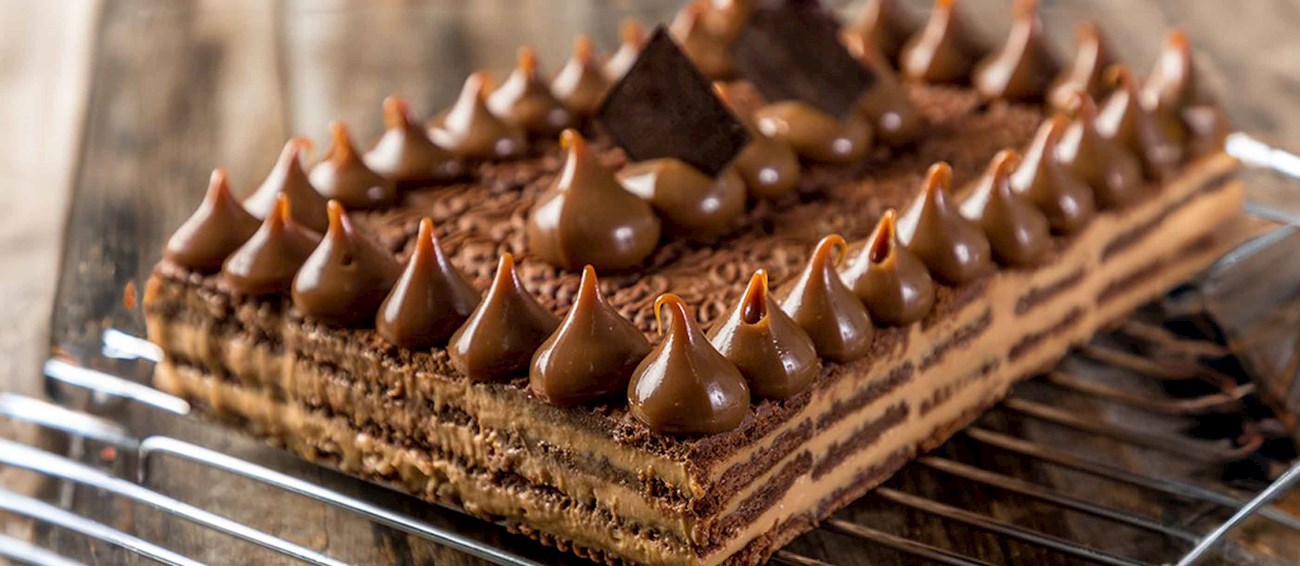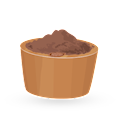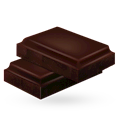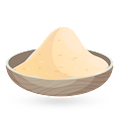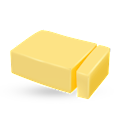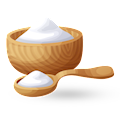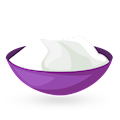Bolo de brigadeiro is a traditional cake that's a staple at birthday parties. The cake consists of three layers of tender and moist crumb, chocolate cake, and the fudgy brigadeiro filling and frosting that's made with a combination of condensed milk, table cream, margarine, chocolate powder, full fat milk, and cornstarch.
The base layer is made with sugar, butter, oil, eggs, vanilla, flour, cocoa powder, baking powder, baking soda, and whole milk. Once assembled and frosted, this cake is decorated with chocolate sprinkles on all sides. Some people also like to decorate this decadent chocolate cake with a few brigadeiro balls on top.
MAIN INGREDIENTS
Translated as chocolate cake, this no-bake Argentinian dessert was influenced by Italian cuisine and modeled on the famous Italian tiramisu. It is made with three Argentinian staple ingredients: chocolate biscuits, dulce de leche, and cream cheese.
The cookies are softened in milk and layered with a combination of cream cheese and dulce de leche. The shapes of chocotorta can vary, while the biscuits can be soaked with chocolate milk, coffee, or even coffee liqueur. The most common theory about its origin says that it was invented as a part of a marketing campaign designed to promote Chocolinas chocolate cookies, and the recipe was included in the packaging.
MAIN INGREDIENTS
Kue lapis or kuih lapis is a traditional dessert that's also popular in Malaysia, Suriname, Brunei, and Singapore. It is usually prepared as a moist layered pudding-like cake consisting of rice flour, sago, sugar, salt, coconut milk, and red, green, or pink food coloring.
The cake is steamed and the final result looks similar to a layered pudding. Before cutting and serving, kue lapis should be left to cool down completely. If properly prepared, this dessert should have a bouncy, sticky, and chewy texture.
Chajá is an Uruguayan cake consisting of layers of sponge cake, whipped cream, meringue, and peaches, while a layer of dulce de leche on top is often seen, but not mandatory. The cake was invented in the 1920s by Orlando Castellano at the Confitería Las Familias in Paysandú.
He was inspired by a local bird, el chajá (crested screamer), and that's how this delicious cake was invented. Nowadays, it is a staple at Uruguayan feasts and celebrations.
MAIN INGREDIENTS
This Argentinian dessert combines layers of crispy puff pastry with dulce de leche. The layers are occasionally coated with crème pâtissière, while the top is sometimes decorated with Italian meringue. It is believed that the cake was modeled on mille-feuille – a classic French dessert consisting of thin layers of pastry and cocoa, almond, or vanilla icing.
Apart from Argentina, similar milhojas varieties are also enjoyed in other South American countries.
MAIN INGREDIENTS
Bolo formigueiro is a traditional cake originating from Brazil. Essentially, it's a sponge cake with chocolate shavings running throughout the dough, hence the name, which means anthill cake. The cake is usually made with a combination of flour, butter, sugar, eggs, milk, vanilla, salt, dark chocolate shavings, and baking powder.
The cake is baked until an inserted toothpick comes out clean, and it's then sprinkled with chocolate shavings once it cools down a bit. The cake can also be glazed, if desired. Bolo formigueiro is especially popular during family celebrations and similar festive occasions.
MAIN INGREDIENTS
This Argentinian dessert is a luscious combination of sponge cake, whipped cream, almond paste, dulce de leche, meringue, walnuts, and candied chestnuts, while the top is dusted with powdered sugar and coconut. Created in 1958, the cake was invented by a pastry chef at a small pastry shop in Balcarce.
The owner Guillermo Talou eventually opened Comoantes – another pastry shop which still operates and sells this traditional cake following the original recipe. Interestingly, Talou sold the recipe to a pastry shop from Mar del Plata, where they gave the cake its current name.
MAIN INGREDIENTS
Rogel is a classic Argentinian dessert consisting of numerous thin layers of dough that are topped with a creamy dulce de leche spread. The cake traditionally includes eight layers, while the top is usually decorated with Italian meringue. Although not much is known about its origin, rogel is a staple on every special occasion in Argentina.
It is also known as alfajor rogel, due to its similarity to sandwiched alfajor cookies.
MAIN INGREDIENTS
Torta negra galesa (or black Welsh cake) is a Patagonian fruitcake invented by Welsh settlers in the Chubut River region in the late 18th century. The settlers wanted to make a cake that would remind them of home and would keep well for weeks or months.
It consists of flour, sugar, butter, almonds, walnuts, candied fruit, and a generous serving of rum. In the region, the fruitcake is typically served as a part of afternoon tea, which is another Welsh tradition.
Unusually, pan de Pascua can be literally translated as Easter cake, but this sweat bread is traditionally eaten at Christmas time. In line with the Italian panettone and the German stollen, two holiday breads from which it has evolved, pan de Pascua is also a rich and dense, loaded with various spices, nuts, and dried fruits.
The sweet bread is usually given an extra kick of flavor by adding a splash of brandy, rum, or pisco—a type of Chilean brandy. It often comes served with a glass of cola de mono (lit. monkey's tail), a Christmas drink made with coffee and alcohol.
TasteAtlas food rankings are based on the ratings of the TasteAtlas audience, with a series of mechanisms that recognize real users and that ignore bot, nationalist or local patriotic ratings, and give additional value to the ratings of users that the system recognizes as knowledgeable. For the “Top 20 South American Cakes” list until February 14, 2025, 1,116 ratings were recorded, of which 524 were recognized by the system as legitimate. TasteAtlas Rankings should not be seen as the final global conclusion about food. Their purpose is to promote excellent local foods, instill pride in traditional dishes, and arouse curiosity about dishes you haven’t tried.
